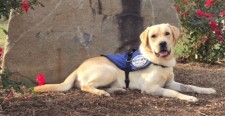Service Dogs by Warren Retrievers Delivers Diabetic Alert

Camden, South Carolina, October 27, 2016 (Newswire.com) - On October 28, Caroline Woolard, 16 year-old daughter of David and Lisa Woolard, of Camden, South Carolina, will be welcoming into her home and heart a Diabetic Alert Dog from Service Dogs by Warren Retrievers. Caroline’s dog, a Labrador Retriever named “Teddy,” has already received thousands of hours of training as a diabetic alert dog and it will continue to learn under the careful guidance of a certified trainer from Service Dogs by Warren Retrievers, “SDWR,” and through the rapport it develops with Caroline and her parents. SDWR has a mission to provide specially-bred and trained dogs for adults and children with invisible disabilities like Autism, PTSD, Seizure Disorders, and Diabetes.
At the young age of just 16 months, Caroline was diagnosed with Type 1 diabetes and in the almost 15 years since the diabetes diagnosis, Caroline and her family have had to face the daily challenges associated with the disease.
"A diabetic alert dog will help me to be able to avoid life-threatening high and low blood glucose levels by alerting before they get so extreme."
Caroline Woolard, New Service Dog Owner
“I had multiple insulin injections each day for about 12 years, but for the past three years I have been on the omnipod system,” says Caroline. Instead of getting shots each day, the pump delivers the insulin through a tube inserted into Caroline. Now, as Caroline becomes more active with school sports, she is coping with high and blood glucose level swings. Those swings are not only life-threatening; they also impact the long-term overall health conditions of a person diagnosed with Type 1 Diabetes.
“Because I run on the cross country and the track teams, I am constantly having various blood sugar level ups and downs,” states Caroline. “A diabetic alert dog will help me to be able to avoid some of these by alerting before they get so extreme.” With the arrival of her service dog, Teddy, Caroline will have another tool, a four-legged one that will indeed alert Caroline to these fluctuating blood glucose levels before they become life-threatening. A three-year study of SDWR Diabetic Alert Dogs funded by the National Institute of Health found that the diabetic alert dogs were able to scent to high and low blood glucose changes often up to 20 to 30 minutes before a blood glucose monitor. This extra time will make an important difference in the safety, security, and long-term health of Caroline as she moves forward in her active teenage life.
Dan Warren, Founder and President of Service Dogs by Warren Retrievers, indicates that the Organization’s diabetes alert dogs are trained to recognize and alert on the scent of low and or high blood glucose levels. “When Caroline’s blood sugar begins to fluctuate, Teddy will pick up the scent and give the alert for ‘high’ or ‘low’ blood glucose levels to Caroline, or if she isn’t right beside him, Caroline’s parents.” In that same study which was conducted by the University of Virginia, it was concluded that SDWR service dogs are 93% accurate in their alerts.
Often diabetics don't feel their blood sugar fluctuation and their bodies are slow to react to how their insulin pumps have been programmed. These events can lead to dangerous lows, which can result in seizures, coma, and even death. Implanted glucose monitoring systems (“CGM”) are often 20 minutes behind an alert dog’s sense of the glucose movement (from April 2013 study by University of Virginia utilizing Warren Retrievers’ service dogs). Electronic systems measure parts per million while alert dogs have been shown to scent parts per trillion.
People may also sleep right through a glucose monitor's alarm, whereas a trained diabetes alert dog is taught to be persistent to the point where it will go get another member of the household if the dog’s “person” does not respond. Additionally, these amazing dogs are trained to retrieve essentials needed such as Glucose tablets, Glucagon, insulin, juice boxes, testing meters or retrieve medication from a designated spot in the house. Alert dogs are further trained to dial out on K-9 equipped phones to summon emergency medical help, if needed.
Caroline’s dog will also work with the SDWR trainers and the Woolard family towards public access certification. Dan Warren is quick to point out that, “all the incredible services these dogs can provide are through progression, hard work and dedication of the Organization and the family who must work together to build on training foundations and fundamentals. This is about an 18-month training program.”
What sets SDWR apart from other service dog organizations are the customized training methods and SDWR matches dogs to their “person.” According to Dan Warren, “that important bonding time between dog and person can begin to happen right away. For the over seven years we’ve been utilizing this method of dog placement, we’ve achieved amazing results. To date we have 500 dogs working across the country and around the globe.”
About Service Dogs by Warren Retrievers
Service Dogs by Warren Retrievers is a non-profit organization based in Madison, Virginia, and relies on donations to help the Organization in its mission, “Until there’s a cure…there’s a dog.” To make or donation or learn more about SDWR, please visit the website, http://www.sdwr.org/. To learn more about Diabetic Alert Service Dogs visit http://www.sdwr.org/service-dogs/diabetic-alert/. To find out how you can volunteer or serve as a puppy raiser visit http://www.sdwr.org/volunteer-opportunities/.
Source: Service Dogs by Warren Retrievers
